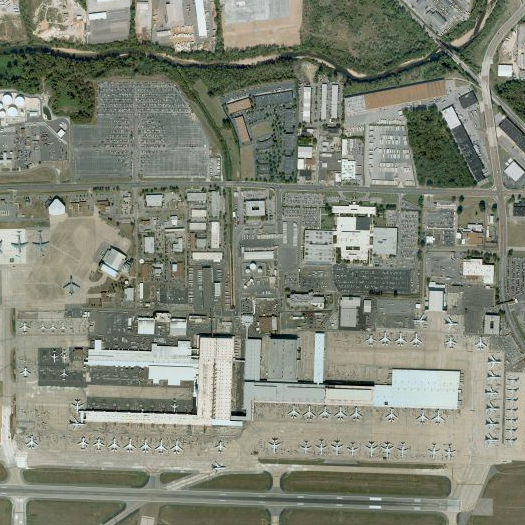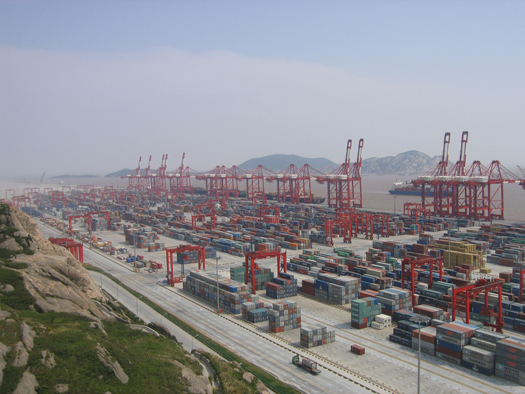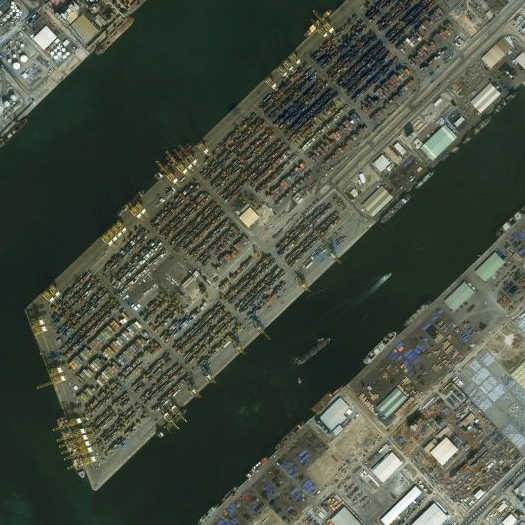
[FedEx’s “Superhub” at Memphis International Airport; via Bing maps.]
1. BLDGBLOG’s Geoff Manaugh interviews Greg Lindsay, co-author (with John Kasarda) of the recently-released Aerotropolis. (If you aren’t familiar with the thesis of the book, you might begin with Lindsay’s recent article in the Financial Times.) The interview is quite interesting, and in places I agree fully with Lindsay’s comments. For instance:
“I think the examples of Memphis and Louisville are fascinating, where the sheer economic force of FedEx and UPS basically willed them into being.
Those cities used to be river-trading towns—cotton and tobacco, respectively—before they became basically southern rustbelt towns. But then, in the 1970s and 80s, they were reborn as company towns of FedEx and UPS. In a sense, their economics—for better or for worse, and that’s very much up for debate—are held hostage by our e-commerce habits: every time we press the one-click button on Amazon, it leads to this gigantic logistical mechanism which, in turn, has led to the creation of these vast warehouse districts around the airports of these two cities.
One of the things I tried to touch on in the book is that even actions we think of as primarily virtual lead to the creation of gigantic physical systems and superstructures without us even knowing it.”
It also seems that Lindsay is quite reflective about the topic, as his critical comments on the relationship between aerotropolis and autocracy or his description of the aerotropolis as a weapon in a “war between cities” make clear, and there’s much to commend in the interview (both in the questions, and in the answers).
[1] A previous post on mammoth, “wyoming is in los angeles”, explores the degree to which cities are materially tied to their “hinterlands”.
I should also note here that Manaugh expresses a related sort of skepticism in his question about “the prospect of a failed aerotropolis” — and so it’s worth reading Lindsay’s answer to that question, though it is more about the future of the aerotropolis than a debate about its present status.
2. However, I’m not convinced that the aerotropolis as Lindsay describes it — a city which is “more closely tied to other cities via air than its own hinterlands” — really exists, or is even possible. Matter matters, and only a little bit of matter and relatively few people (at great energy cost) can realistically be transported frequently by air [1]. Maybe 100 million Chinese tourists really will be flying abroad in 2020 — but even that massive quantity is only one out of every thirteen Chinese (on China’s current population), and those 100 million wouldn’t be people whose lives are characterized by air travel, but people whose lives occasionally — perhaps annually, perhaps bi-annually — feature air travel on special occasions.
3.More interesting than quibbling about the nature of aerotropolis, though, is Lindsay’s assertion that aerotropolis is crystallized globalization:
“The notion of the aerotropolis, then, is basically that air travel is what globalization looks like in urban form. It is about flows of people and goods and capital, and it implies that to be connected to a city on the far side of the world matters more than to be connected to your immediate region.”
It seems to me that the “aerotropolis” (particularly on the more restricted Kasarda definition) is more a symbol of globalization than it is the ultimate instantiation of globalization. Sea shipping is (and was for centuries before the invention of flight) the dominant mode of global transport. To get an indication of the difference in magnitude between sea and air shipping, just look at Shanghai, the world’s busiest cargo port by tonnage, and Memphis, the world’s busiest airport by tonnage: Memphis sees about three million tons a year; Shanghai sees around five hundred million tons a year. This is not a statistical aberration.

[Yangshan Deepwater port, off the coast of Shanghai — merely one of Shanghai’s many container-handling facilities; image source.]
If you want to connect to the global economy you build a port. (Karrie Jacobs: “Even Dubai, which seems to demonstrate how a good airport (and a state-owned airline) can make a city materialize from thin air, initially tested the economic value of a free-trade zone on the Persian Gulf by building a state-of-the-art shipping port.”) Failing that, you build an inland port, to receive and distribute goods from a sea port. Yes, if you want to connect to certain specific components of the global economy which require high-value and high-speed material transactions (the small auto-parts industry, for instance), you build an airport, but, just as with the movement of people, that’s a special case, not the baseline.
Even Air Cargo World (which has an obvious interest in air cargo boosterism) admits that sea shipping is hardly the way of the past:
Four years ago this month, Giovanni Bisignani, the director general and CEO of the International Air Transport Association (IATA), sounded the alarm to airfreight experts assembled at the IATA World Cargo Symposium in Mexico City.
“Ocean container shipping is becoming more competitive and taking business away,” Bisignani told the audience during his opening address. He then rattled off some startling numbers. Growth in the ocean sector from 2000 to 2005 more than doubled airfreight growth, and from 2006 to 2010, ocean freight was to outpace annual air cargo growth by nearly 2 percent.
“New container ships are faster and cheaper to operate,” he continued. “2006 ocean container freight rates were 20 percent in real terms below 2000 levels. Airfreight rates were only 8 percent lower. … We can expect more intense price competition”
…
Now that a resurgence is taking place in both the ocean and air cargo industries, shippers are starting to plan for the future. It’s been reported that shippers who once operated only in the sky and had gone to the water are making the shift back to air cargo, but there isn’t enough evidence to suggest a trend is underway. A lot is happening in the shipping industry, and it’s difficult to say how many shippers are returning to the skies, just as it can’t be said that some shippers will remain sea-bound forever. As with most things, the issue isn’t clear cut.
“I have seen some conversion of sea to air, and we certainly saw it for a lot of 2010,” Shah says. “I don’t know if that trend is still continuing. It probably is, but it probably depends and the commodity, and it depends on the industry.”
If you’re looking for a physical instantiation of the ways that contemporary globalization is radically different than 19th-century globalization (and you’re not satisfied with the shipping container, which really is one of the most important innovations of the twentieth century), then I’d suggest that the tubes are a better place to start than the airports.

[Container shipping in the aerotropolis of Dubai — like Shanghai, one of many terminals.]
4. I do wonder if there is an element of unintentional bias operating in the formulation of Lindsay and Karsada’s theses? If you’re wealthy (or fortunate enough, like I am, to be middle-class in a country where the middle-class is wealthy by global standards), you might connect to the world by flying around it; but if you’re not, you probably connect to the world — experience globalization — through the products you participate in the manufacture, design, storage, marketing, or sales of, the products you purchase, and/or the raw materials that you participate (directly or indirectly) in the extraction of. If your experience primarily falls into the former category — experiencing the world by traveling it in airplanes — it would be unsurprising if this biased you towards overestimating the significance of airports as drivers of urbanization, and underestimating the impact of the latter items on urbanization.
5. All that said, the existence of the aerotropolis, whatever its fate, future, and ultimate importance is, seems undeniable, and so I’m convinced that this is an important and fascinating phenomenon, well worth studying.
[In return, Greg Lindsay interviews BLDGBLOG. Lindsay and Manaugh will be continuing these conversations at upcoming live events — click through to BLDGBLOG’s interview for details. Elsewhere, Kazys Varnelis reacts — with appropriate suspicion about the future prospects for jet-setting global citizens of the aerotropoli — to commentary and chatter surrounding the release of Aerotropolis.]


[…] le nom de la ville repensée à l’échelle globale de l’infrastructure logistique devenue essence du monde. Il sera alors très difficile de pallier l’absence généralisée de relations humaines dans un […]
[…] Andrew Blum asked twitter for questions for Lindsay. I responded with the central point from my previous post on […]
[…] vision and democracy, see Alon Levy’s post on consensus and vision) Back in March, mammoth made the case that the aerotropolis is merely the symbol of globalization. Air travel might be the sexy mode, […]
[…] As critical as trade may be, there’s more to it than just that. Likewise, as mammoth notes, airborne trade is but a small fraction of the overall flows. Even if the flows of capital, […]